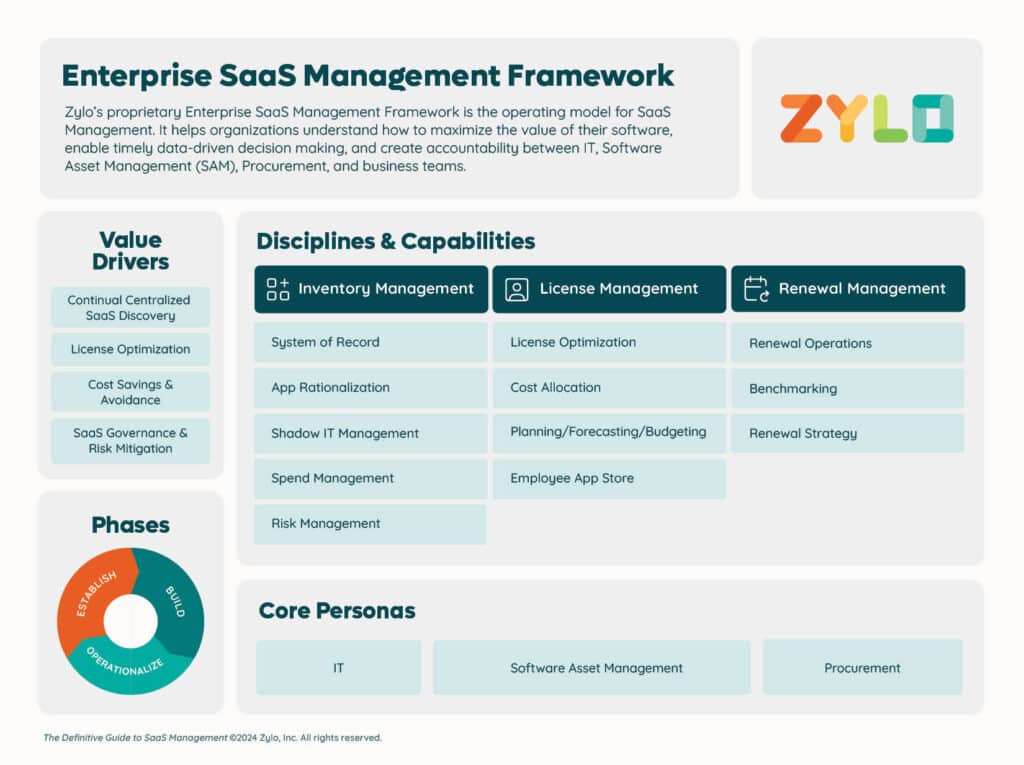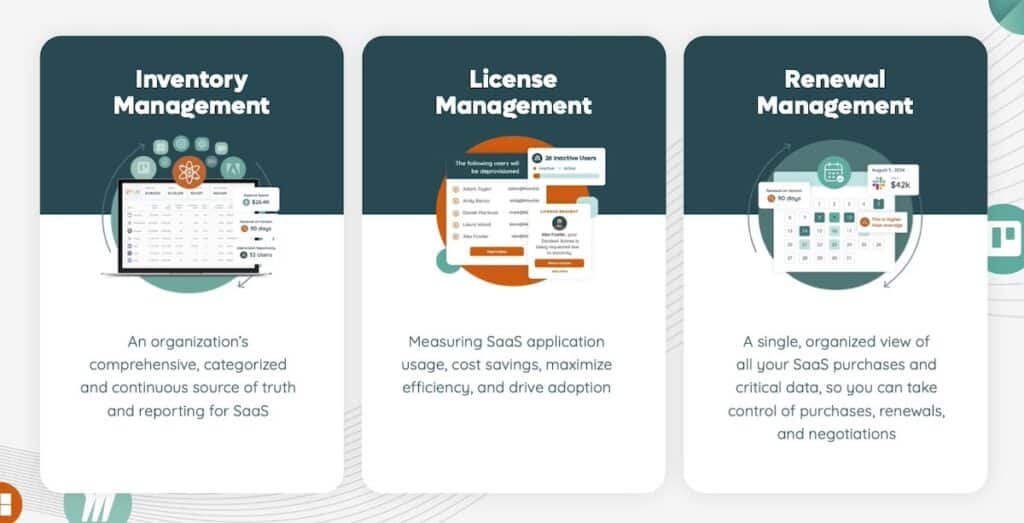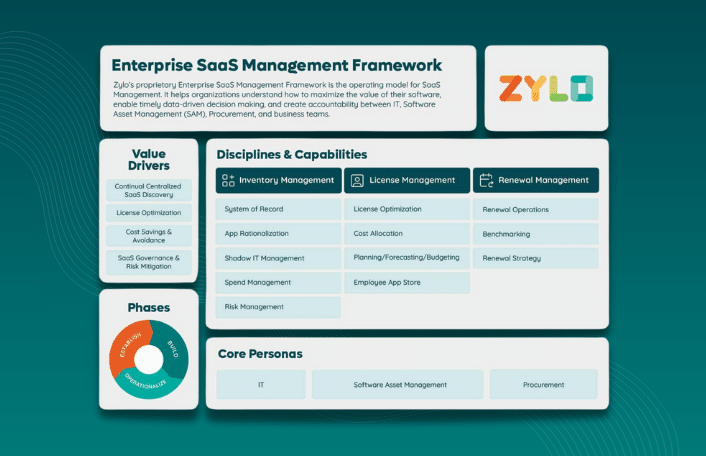Table of Contents
As we move further into the fast-paced landscape of digital transformation, SaaS has emerged as a focal point of efficiency and agility for businesses worldwide. Gartner’s recent conclusion that “The time is now for SaaS Management” encapsulates the urgency with which organizations must approach the management of their SaaS ecosystem. As SaaS spend continues to surge at an impressive 25% Compound Annual Growth Rate (CAGR), the necessity of strategic management is more apparent.
Amidst this growth, some alarming statistics loom: Gartner estimates that at least 30% of SaaS licenses are squandered. The security landscape is also evolving with the proliferation of SaaS applications — companies failing to implement a SaaS Management Platform (SMP) are five times more vulnerable to cyber incidents.
The need for robust enterprise software management practices has never been more apparent. Join us as we delve deeper into SaaS Management, exploring its pivotal role in navigating the complexities of the digital age and unlocking the full potential of cloud-based solutions.
SaaS Plagues the Enterprise with Many Challenges
Somehow, despite your best efforts, critical aspects of managing your SaaS applications remain out of sight. You can’t gain visibility into which applications your teams procured, or worse, what licenses you own and their associated costs. You know licenses are going to waste, and you have more than you need, but you don’t know by how much.
The looming specter of renewals adds another layer of concern. With contracts, agreements, and costs scattered throughout disparate systems, maintaining a cohesive plan is a struggle. But the most unsettling aspect is the hidden risks lurking beneath the surface. Without a clear view of your software landscape, you’re exposed to potential security breaches and compliance pitfalls.
It’s a troubling scenario that leaves even the most seasoned leaders feeling adrift. But there is a solution to cut through the chaos and regain control over your SaaS environment: establishing a SaaS Management program.
2024 SaaS Management Index
Learn MoreWhy the Challenges of SaaS Are Hard to Overcome
If you don’t start taking control of SaaS, you’ll quickly find yourself facing significant financial and operational challenges. But solving these challenges isn’t easy. There are five primary reasons why:
#1 SaaS Management Is A New Business Practice
Because SaaS Management is a relatively new business practice, there aren’t established strategies and best practices to guide you. Teams often find themselves in uncharted territory, lacking the right expertise or tools to operationalize a program. In addition, most companies haven’t done this before; they’re often starting from square one. All of these factors combined create uncertainty on where to get started.
#2 Your SaaS Environment Is Constantly Changing
Even if you manage to gain control of your SaaS portfolio today, maintaining that control requires ongoing effort. Simply organizing it once or focusing solely on managed applications won’t provide a lasting solution. That’s because new apps are constantly being adopted, existing ones change, and employee needs evolve.
#3 SaaS Purchasing Is Decentralized
Unlike traditional software that might be procured and managed centrally, SaaS products are often managed by individual departments or employees. This decentralized approach can lead to redundancy, overspending, and a lack of oversight, complicating how resources are allocated and controlled.
#4 Working in Silos Becomes Counterproductive
Effective SaaS Management requires coordination across multiple organizational departments, including IT, finance, procurement, and the business units using the software. This requires a cross-functional approach that can be challenging to orchestrate, as each department has its own priorities, budgets, and goals.
#5 The Value of SaaS Management Is Broad
While benefits like cost savings are tangible, other advantages of SaaS Management—like enhanced security and improved software utilization—can initially seem undefined. Organizations may find it difficult to quantify the value of SaaS Management, making it challenging to justify the initial investment and ongoing effort.
Benefits of SaaS Management
Once you recognize the need for SaaS Management, it’s important to focus on the benefits to increase buy-in across departments and gain the support of key decision makers.
- Increased Visibility: Achieve a comprehensive view of your organization’s SaaS subscriptions, enhancing your ability to make informed decisions about software usage and needs.
- Enhanced SaaS ROI: Optimize the returns on your SaaS investments by ensuring that every tool is fully utilized and aligned with your business objectives.
- Cost Efficiency: Identify and eliminate wasteful spending by reducing unused or underutilized subscriptions, leading to significant cost savings.
- Improved Collaboration: Facilitate better teamwork and efficiency by providing the right tools that support seamless collaboration across different departments.
- Enhanced Security: Strengthen your security posture by maintaining tight control over software access and compliance, reducing the risk of data breaches and other security threats.
The Enterprise SaaS Management Framework
You recognize the benefits of SaaS Management and are determined to start a program. How do you actually do it?
To effectively manage SaaS at scale across the enterprise, a robust framework is essential. Zylo’s proprietary Enterprise SaaS Management Framework – the first of its kind – is the operating model for SaaS Management. It helps organizations understand how to maximize the value of their software, enable timely data-driven decision making, and create accountability between IT, Software Asset Management (SAM), Procurement, and business teams.

Read on or watch the video below for an overview of the framework. For a deeper dive, check out The Definitive Guide to SaaS Management.
This framework breaks down SaaS Management into a phased, iterative format. That way, it’s easy to understand how to build a strategy, take impactful action, drive business value, and mature your program. It encompasses the following key elements:
- Disciplines: Disciplines represent an area of activity within SaaS Management and include Inventory Management, License Management, and Renewal Management. In short, it gives you clarity on the core areas of focus and expertise required for success.
- Capabilities: Capabilities outline the functional activities that can be performed as part of a Discipline. For example, Inventory Management includes Capabilities such as system of record, application rationalization, and shadow IT management. To build a strong foundation, organizations should start small. As such, each Capability follows a phased approach.
- Tactics and Actions: Tactics and Actions are the necessary steps to execute each Capability. Continuing with the previous Inventory Management example, the system of record Capability includes Tactics and Actions such as governance, integrations, and app discovery. In some cases, Tactics and Actions may overlap between Capabilities.
- KPIs (Key Performance Indicators): Establish measurable KPIs to track the success of your SaaS Management efforts. KPIs should align with your strategic business outcomes, whether that’s inventory visibility and insights, realized cost savings, cost avoidance, or a record of compliance. These may include metrics such as SaaS spend as a percentage of revenue, software utilization rates, cost savings achieved through optimization initiatives, and compliance with security policies and regulations.
By implementing the Enterprise SaaS Management Framework, you can effectively navigate the complexities of managing SaaS at scale and unlock business value to its full potential.
3 Disciplines of SaaS Management
Within the Enterprise SaaS Management Framework, there are three disciplines. Performed together, you can minimize risk, maximize savings, and increase operational efficiency for your business. Let’s examine each in closer detail.

Inventory Management
Inventory Management is an organization’s comprehensive, categorized, and continuous source of truth and reporting for SaaS. It’s critical to prioritize Inventory Management as the foundational first step of your SaaS Management program. That’s because it provides complete, real-time visibility into every application in your ecosystem and associated spending and risks across your organization.
By starting here, all stakeholders – IT, SAM, and Procurement – can make data-driven decisions versus those based on opinion. More importantly, centralizing this data creates the compass for where to start your SaaS Management journey.
Capabilities of Inventory Management include:
- SaaS system of record
- Shadow IT management
- App rationalization
- SaaS spend management
- Risk management
License Management
License Management measures SaaS application use, maximizes efficiency, removes waste, and drives adoption. To be successful, it requires real-time visibility into licensing and usage, and ongoing effort. That’s because your business is dynamic. License needs change as your business grows and contracts, adoption and usage shifts, and apps continually enter and exit your ecosystem.
Capabilities of License Management include:
- License optimization
- Cost allocation
- Planning/forecasting/budgeting
- Employee app store
Renewal Management
Renewal Management focuses on providing a single, organized view of all your SaaS purchases and data, so you can effectively control purchases, renewals, and negotiations. Tracking renewal dates is critical for SaaS, because it’s the only opportunity to have to make changes to your contract – such as pulling back licenses, reviewing commercial terms, negotiating price/terms, and introducing new security requirements. You must understand and build a process around each renewal to drive your desired outcomes.
Capabilities of Renewal Management include:
- Renewal strategy
- Renewal operations
- Benchmarking
The Definitive Guide to SaaS Management
Learn MorePhases of the Enterprise SaaS Management Framework
Taking a phased approach to SaaS Management allows you to first build a solid foundation for your program and iterate as time goes on. The Enterprise SaaS Management Framework is broken down into three phases.
- Phase One: Establish a Foundation – Start small. This means building a SaaS system of record, prioritizing Tier One apps, centralizing critical SaaS data, and obtaining quick wins to validate your program.
- Phase Two: Build Your SaaS Management Program – Expand your program across Tier Two applications, operationalizing license workflows, establishing governance policies, and rationalizing applications.
- Phase Three: Operationalize Your Program – Expand your program to include Tier Three apps, starting strategic projects like chargebacks, budgeting, and application catalog, and scaling license reclamation.
Use the Enterprise SaaS Management Framework as Your Roadmap
The Enterprise SaaS Management Framework, the first of its kind, is a powerful tool. But how do you use it? If your destination is a mature SaaS Management program, then the framework is your roadmap, and Inventory Management is your compass. Follow these steps:
- Take stock of your SaaS inventory.
- Assess your current state within each capability.
- Define your desired future state and the “why” behind each goal.
- Prioritize which Capabilities to address and establish clear objectives within a defined timeline.
By mastering the three key disciplines of inventory management, license management, and renewal management, your organization can unlock the full potential of its SaaS investments. The framework is just part of getting there. Organizations that prioritize SaaS Management – with the right resources and tools to help them – will accelerate business goals and maintain a competitive edge.
ABOUT THE AUTHOR

Ben Pippenger
Ben Pippenger is Staff Product Manager and Co-Founder of Zylo, where he helps enterprises maximize the value of their SaaS investments. With more than 20 years of experience in B2B software, Ben is a recognized thought leader in SaaS Management, license optimization, and IT strategy. Before founding Zylo, he held product and account leadership roles at Salesforce and ExactTarget. A self-proclaimed SaaS geek, Ben regularly speaks on topics like shadow IT, SaaS ROI, and software lifecycle management.

